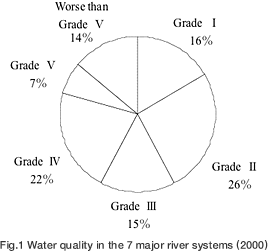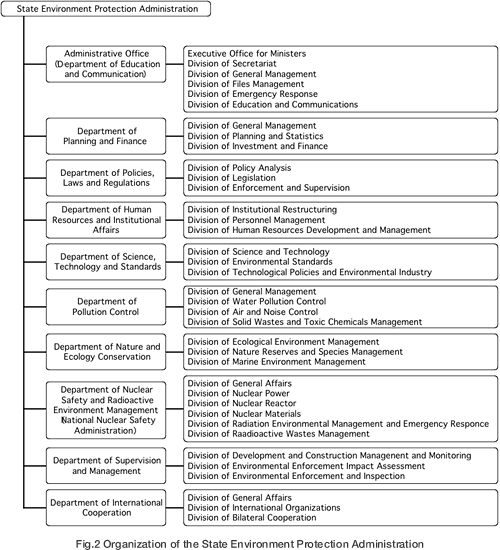|
 |
 |
| Environmental Status |
| Marine environment |
Water quality
Table 1 Status of water quality in the coastal
area (2000) |
| Sea area |
Monitoring
points |
Ratio (%) |
| Grade I |
Grade II |
Grade III |
Grade IV |
Exceeding
Grade IV |
| Bohai Sea |
70
|
8.5 |
50.0 |
12.9 |
15.7
|
12.9 |
| Huanghai Sea |
141 |
22.7 |
47.5 |
13.5 |
4.3 |
12.0 |
| Donghai Sea |
120 |
0 |
20.0 |
14.2 |
19.1 |
46.7 |
| Nanhai Sea |
46 |
36.9 |
19.6 |
17.4 |
2.2 |
23.9 |
| Total |
377 |
14.6 |
35.7 |
14.1 |
10.9 |
24.7 |
|
| Note : Depending on water use / conservation objectives, water quality is classified into 4 grades, with corresponding standard values. For COD, standard values of 2,3,4,5mg/L are set for Grades I - IV respectively. |
The coastal area of China can be classified into 4 major sea areas, the Bohai Sea, Huanghai Sea, Donghai Sea and the Nanhai Sea.
According to the water quality monitoring results of 2000, within the above seas, 14.6% of the monitoring stations were classified as Grade I water quality, 35.7% as Grade II, 14.1% as Grade III, 10.9% as Grade IV and the remaining 24.7% as exceeding the Grade IV standard.
Water pollution was most serious in the Donghai Sea, especially along the coasts of the Shanghai and Zhejiang Provinces (Table 1). |
 |
Marine pollution
| Table 2 Number of red tide occurrences in different sea areas (2000) |
| Sea area |
No. of occurrences |
Total area
(km2) |
| Bohai Sea |
7
|
2,000 |
| Huanghai Sea |
4 |
800 |
| Donghai Sea |
11 |
7,800 |
| Nanhai Sea |
6 |
50 |
| Total |
28 |
10,650 |
|
In 2000, 28 red tides were recorded culminating into a total area of over 10,000 km2. Within the region red tides are frequently observed in Liaodong Bay, the Bohai Sea and the northern coast of Huanghai Sea (Table 2).
|
 |
| River environment |
Water quality
China has 7 major river systems*1, the Changjiang River (Yangtze River), Huanghe River (Yellow River), Zhujiang River (Pearl River), Songhuajiang River, Huaihe River, Haihe River and Liao River.
Within the 7 major river systems, nearly 60% of the monitoring points were classified under the Grade III water quality standard*2, 21.6% were Grade IV, 6.9% were Grade V and 13.8% were above the Grade V standard.
Pollution levels were found to decrease in magnitude between river systems in the following order; Liao River, Haihe River, Songhuajiang River, Huanghe River, Songhuajiang River, Zhujiang River and Changjiang River. Most of the pollution seemed to be concentrated in urban areas. |
 |
*1 : In China, 77% of surface water resource is dependent on the 7 major river system and 90% of the population conduct socio-economic activities in the basins of the 7 major river system.
*2 : Depending on water use / conservation objectives, water quality is classified into 5 grades, with corresponding standard values. For BOD, standard values of 3,3,4,6,10mg/L are set for Grades I - Vwere above the Grade V standard.
|
 |
| Table 3 Water quality in the 7 major rivers (2000) |
| River Basin |
Annual average BOD (mg/L) |
Changjiang River
(Yangtze River) |
0.55 - 2.59 |
Huanghe River
(Yellow River) |
1.17 - 3.8 |
Zhujiang River
(Pearl River) |
0.3 - 31.75 |
| Songhuajiang River |
1.86 - 4.31 |
| Huaihe River |
1.43 - 4.43 |
| Haihe River |
1.0 - 89.59 |
| Liao River |
1.61 - 32.23 |
|
|
 |
Status of sewage treatment
As of 1999, urban sewage systems covered over a total length of 130,000 km with a treatment capacity of 27 million m3 per day. However, the amount of waste water is rapidly increasing due to increases in population and urbanization. Currently the waste water treatment rate in China is only 25.8% and for the region it is between 18.1-35%. |
respectively.
* : Air quality standard for SO2, NO2, PM-10 are classified into 3 grades. For SO2, standard values of 0.02, 0.06, 0.10mg/m3 are set for the 3 grades. |
 |
| Atmospheric environment |
In China, SO2 and SPM are the major air pollutants with vehicle exhaust gas additionally contributing to pollution in major cities. This is mainly due to the intense reliance (approximately 75%) on coal as an energy source and this problem is further compounded due to the use of coal with high sulfur content.
According to the monitoring surveys conducted in 2000 for 338 cities, 40% of the cities were under the Grade II air quality standard. The remaining 60% of these cities were above Grade II air quality standard and within these cities one-third exceeded Grade III air quality standard*. |
 |
respectively.
* : Air quality standard for SO2, NO2, PM-10 are classified into 3 grades. For SO2, standard values of 0.02, 0.06, 0.10mg/m3 are set for the 3 grades. |
 |
| Table 4 Air quality in major cities of China (2000) |
| Province / city |
Annual average value (mg/m3) |
| NOx |
SO2 |
SPM |
| Heilongjiang |
Harbin |
(0.022) |
0.029 |
0.242 |
| Daqing |
0.026 |
0.008 |
0.118 |
| Jilin |
Shanxi |
(0.063) |
0.067 |
0.557 |
| Changchun |
(0.028) |
0.012 |
0.265 |
| Liaoning |
Dalian
|
0.035 |
0.017 |
0.088 |
| An Shan |
0.064 |
0.076 |
0.418 |
| Hebei |
Shijiazhuang |
0.090 (0.057) |
0.169 |
0.431 |
| Tangshan |
— |
0.084 |
0.352 |
| Shanxi |
Taiyuan |
0.093 |
0.200 |
0.401 |
| Datong |
0.041 |
0.172 |
0.721 |
| Shandong |
Jinan |
— |
0.059
|
0.173 |
| Qingdao |
0.034 (0.025) |
0.055 |
0.143 |
| Anhui |
Hefei |
(0.046) |
0.013 |
0.170 |
| Jiangsu |
Nanjing
|
0.048 (0.037) |
0.029 |
0.107 |
| Xuzhou |
0.044 |
0.026 |
0.323 |
| Henan |
Zheng Zhou |
— |
0.039 |
0.291 |
| Luo Yang |
— |
0.064 |
0.354 |
| Beijing |
0.126 (0.071) |
0.071 |
0.353 |
| Tianjin |
0.053 (0.045) |
0.056 |
0.304 |
| Shanghai |
0.091 (0.061) |
0.046 |
0.156 |
|
| Note : Parenthesis in the NOx
column indicates NO2 concentration |
|
 |
| Environmental Administration |
Administrative structure
The State Environment Protection Administration plays a central role in the environmental policy of China. Its main tasks involve the establishment of environmental protection policies, preparing laws and regulations, the conservation and management of the natural environment and the safe management of nuclear power.
Other related administrations include the Ministry of Water Resources and the Ministry of Agriculture, which within a range of tasks concentrate their work efforts on water resource management as well as the protection of marine flora and fauna. |
 |
 |
Environmental laws and regulations
“The Environment Protection Law” enacted in 1989 is a basic environmental law. Its principal aim, as written in Article 1 is to protect and improve the living and ecological environment, protect human health by preventing and controlling pollution and support the modernization of socialism.
Under the above law, various individual laws concerning the protection of the air, water and soil quality are enacted (Table 5).
- “Three-at-the same-time” system
In order to cope with expected pollution during the constructing, remodeling and extending of a factory, developers should plan, construct and operate environmental protection facilities in synchronous with the planning, construction, and operation of the factory.
This system is called a “Three-at-the same-time” and is unique to China.
- Polluter pays system
This is the system in which a “polluter- pays- principle” is embodied. Under the system the polluter must pay a “pollution fee” when waste water, exhaust gas or solid waste exceeds the national or local emission standards. |
| Table 5 Major environmental laws (1) |
| Category |
Laws |
| Basic Law |
- Environmental Protection Law (promulgated in 1989.12.26) |
Air
Noise and
Vibration |
- Law for the Prevention and Control of Atmospheric Pollution (promulgated in 1987.9.5)
- Law for the Prevention and Control of Environmental Noise Pollution (promulgated in 1989.9.26)
Examples of regulations and standards for air pollution, noise / vibration
- Ambient Quality Standard
- Integrated Emission Standard of Air Pollutants
- Emission Standard for Exhaust Pollutants from Gasoline Engine of Vehicle
- Standard of Vibration in Urban Area Environment
- Standard of Environmental Noise of Urban Area |
| Water |
- Law for the Prevention and Control of Water Pollution (promulgated in 1984.5.11)
- Marine Environment Protection Law (promulgated in 1982.8.23)
Examples of regulations and standards for water pollution
- Environment Quality Standard for Surface Water
- Sea Water Quality Standard
- Integrated Wastewater Discharge Standard
- Standards for Drinking Water Quality
- Standards for Irrigation Water Quality |
| Soil |
- Law for Water and Soil Conservation (enacted in 1991.6.29)
Examples of regulations and standards for soil pollution
- Environmental Quality Standard for Soils
- Law on Pesticide Management
- Control Standards for Pollutants in Sludges from Agricultural Use |
|
|
 |
| Table 6 Major environmental laws (2) |
| Category |
Laws |
Waste
Recycle
|
- Law for the Prevention and Control of Environmental Pollution
by Solid Waste (promulgated in 1995.10.30)
Examples of regulations and standards for waste
- Law on Pesticide Management
- Standard for Pollution Control on the Municipal Solid Waste Incineration
- Standard for Pollution Control on the Landfill Site for Domestic Waste
- Control Standards for Urban Wastes for Agricultural Use
- Control Standard on Poly chlorinated biphenyls for Wastes |
Natural
Resources |
- Forestry Law (enacted in 1984.9.20)
- Grassland Law (enacted in 1985.6.18)
- Fisheries Law (enacted in 1986.1.20)
- Mineral Resources Law (enacted in 1986.3.19)
- Law of Land Administration (enacted in 1986.6.25)
- Water Law (enacted in 1988.1.21)
- Wildlife Protection Law (enacted in 1988.11.8)
- Law for Water and Soil Conservation (enacted in 1991.6.29)
- Law on the Coal Industry (enacted in 1996.8.29)
Examples of regulations and standards for natural resource protection
- Law on Marine Resource Conservation
- Regulations for Natural Preservation zones
- Regulations for the Preservation of Wild Plants
- Law on Pesticide Management
- Regulation on Land Recovery |
|
|
 |
 |
|

